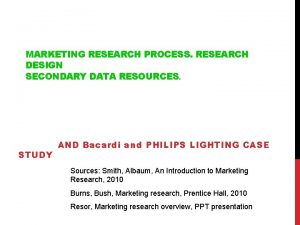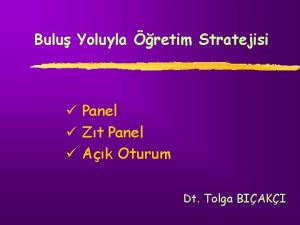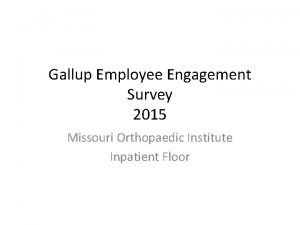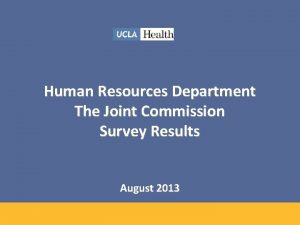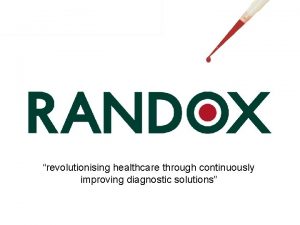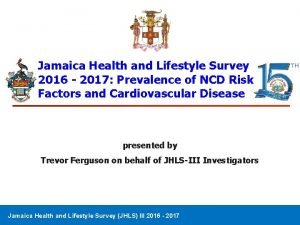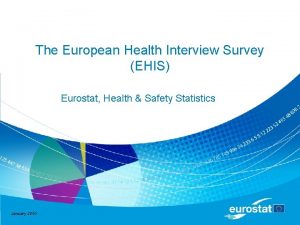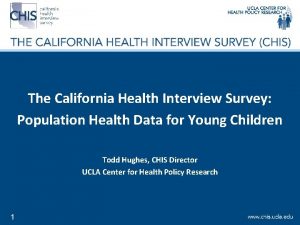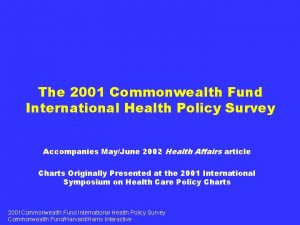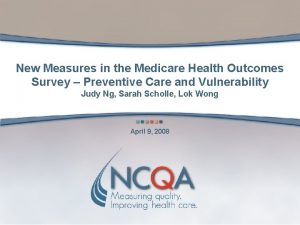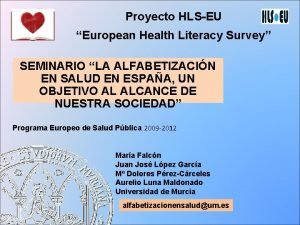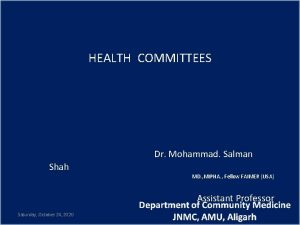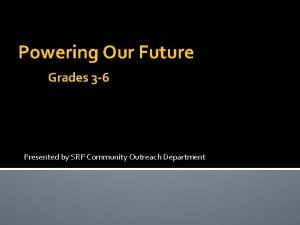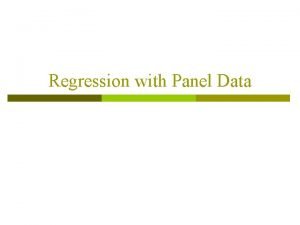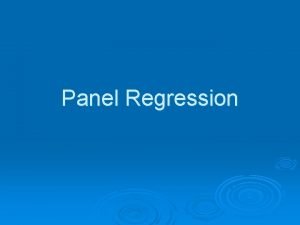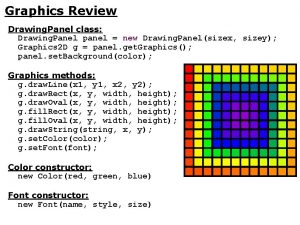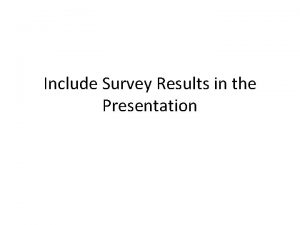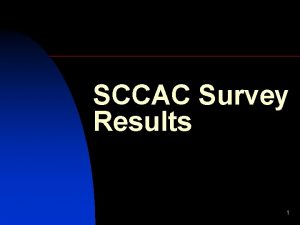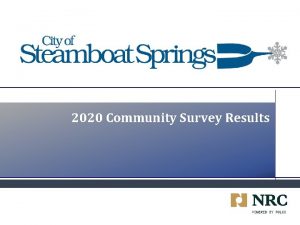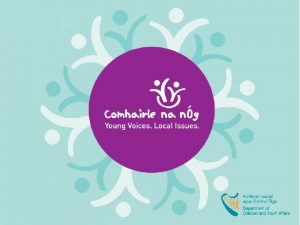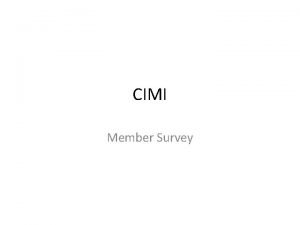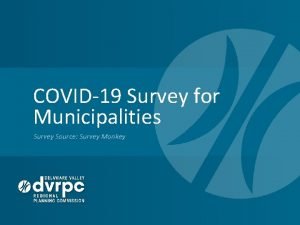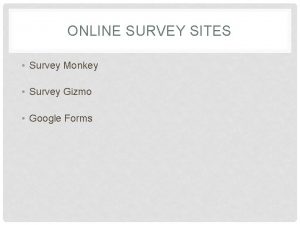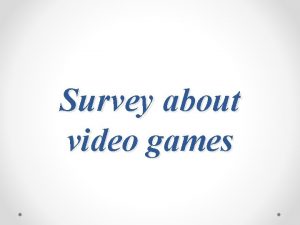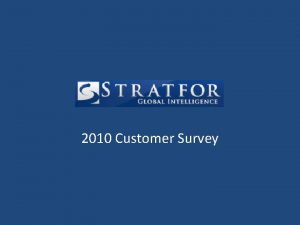Our Health Our Future Panel Survey 2 results








































- Slides: 40

Our Health Our Future Panel Survey 2 results – A survey on Covid-19 and Digital Technology / Video Consultation Survey conducted 4 th to 20 th May 2020

Report structure 1 Introduction Page 2 2 Overview summary Page 7 3 a Survey 2 Results – Coronavirus Page 10 3 b Survey 2 Results – Digital technology and video consultations Page 24 Appendices – Panel profile Page 34 4 1

Section 1 Introduction 2

Section 1 - Introduction Vision and mission of the Our Health Our Future Panel ‘’ The Our Health, Our Future (OHOF) Panel is a new way for us to engage with those living in Bath and North East Somerset, Swindon and Wiltshire (BSW) to get their views on health and care issues. In line with our value of "inclusive", the online panel is made up of a representative sample of the population from across our region. Panel members will take part in regular surveys throughout the year. Panel surveys will inform both strategic direction and day-to-day service delivery, particularly around proposed service change or development of new services. Anonymised feedback will be shared with project managers and senior leaders to help shape and influence partnership initiatives and programmes of work. Anonymised feedback will also be made publicly available so panel members and the wider public will have the opportunity to review the results ‘’ 3

Section 1 - Introduction Recruitment methodologies - 790 panellists recruited so far 1) Core recruitment – face to face • 21 face to face recruitment days have taken place between January and early March 2020 • A mixture of community days in town halls, libraries, community & social centres, shopping malls and cafes/inns • Along with individual interviewers conducting face to face on-street shifts, among local communities in less busy locations • These have been spread right across the BSW region, including • Bath, Midsomer Norton • Swindon • Devises, Marlborough, Trowbridge, Warminster, Salisbury, Amesbury, Chippenham • F to F recruitment was the preferred core method: both to avoid self-selection and to enable specific targeting of a representative sample of citizens in many different geographic locations, a total of 742 panellists have been recruited via this method 2) Additional recruitment methods • These have included social media advertising on Facebook and Instagram, member get member (panelists promoting to their contacts), engagement with local organisations and promotion by BSW CCG via it’s website, social media and contacts • An additional 48 panellists have joined via these methods 3) Pause for Covid-19 • A total of 790 panelists have been recruited so far, all but 2 were recruited before the Government announced lockdown measures on March 23 rd • Face to face recruitment will resume when lockdown measures are eased and it is safe to do so, the target number of panellists is 1, 000 • This additional recruitment allows an element of boosting of certain categories of citizen’s, such as younger people and hard to reach audiences • The interaction with the professional recruitment team also provides an opportunity for a clear introduction to and explanation of the Panel’s purpose Ø Panelists will complete up to 4 surveys per year online. Jungle Green also conduct some interviews by telephone and postal questionnaire if the respondent has chosen these alternative methods 4

Section 1 - Introduction Recruitment tracker as at May 29 th 2020 5

Section 1 - Introduction We have a robust and representative sample to work from. The focus from now will be to increase the proportion in B&NES and reach the 1, 000 panellist target % of BSW entire population/survey 2 participant rim weighted profile (381) (790) B&NES 22% 10% 27% Swindon 29% 51% Wiltshire Male 37% NB: Survey 2 participants’ responses have been rim weighted to reflect the exact profile of the BSW population (according to census data and JNSA). 63% A more detailed panel profile is given in Section 4 of this report. 15% 16 -24 years 16% 32% 25 -44 29% 32% 45 -64 37% 11% 65 -74 14% 10% 4% 94% White BAME 61% 49% 51% Female 75+ years % of our actual panellist profile as at May 2020 91% 6% 9% 6

Section 2 Overview summary 7

Section 3 – Overview summary Keeping well during the coronavirus period, attitudes and behaviours 90% of BSW residents reported feeling healthy at this time, a higher number than pre-lockdown survey 1. Perhaps due to the majority not reporting any covid-19 symptoms One half of BSW residents reported feeling uncertain, however an equal proportion said they are hopeful (nb. hopefulness doubled since 2 weeks earlier, perhaps due to the easing of lockdown measures) A smaller proportion, 69%, of BSW residents felt in control of their lives, compared to pre lockdown survey 1 A smaller proportion, 66%, of BSW residents reported feeling happy, compared to pre lockdown survey 1 In addition, one third of BSW residents report feeling lonely in the coronavirus period. These are understandable results due to the unprecedented situation being faced. A majority, around 9 out of 10, BSW residents feel they know how to protect themselves against coronavirus and are following guidance to prevent the spread Physical health (67%) and mental health (55%) are the TOP TWO concerns about the impact of Coronavirus on individuals and their families at the moment, these are followed by social contact (35%) and isolation (20%) The main actions taken to look after one’s emotional wellbeing and mental health in response to the coronavirus situation were: speaking more often with family/friends, spending time outside, taking regular exercise and reading a book /watching TV 8

Section 3 – Overview summary Health/care services used & communications during coronavirus / digital technology & video consultations 42% of BSW residents report that they have used or tried to use health and care services in the last month during the coronavirus period. The majority of the need, over 90%, was for routine care. Only 1 in 10 users reported that they found it quite difficult to access care The perceived benefits of video consultations centre on the reduced risk of spreading contagious diseases and the lack of need to travel / less time required / greater convenience The perceived challenges of video consultations centre on concerns about access to technology and the limitation of the interactions e. g. no physical examination, impersonal and awkward The main sources of information about the latest news/guidance on Covid-19 are National and local TV and online news. More than 9 in 10 BSW residents could recall seeing the ‘Stay Home’, ‘Keep 2 m apart’ and ‘Wash your Hands for 20 seconds’ campaign messages in the previous 2 weeks People are directionally less likely to be comfortable using video consultations for new or ongoing mental health or emotional wellbeing concerns Flexible, convenient booking, with HCP’s people already know may help to drive further uptake of video consultations Almost three quarters of participants agree to some extent that digital technology, in general, has made life easier for them. While face-to-face and/or telephone consultations are typically preferred for accessing different health and care services, it’s clear that video consultations are roughly equally popular with these methods for follow-up appointments On being given a description of what a video consultation entails, almost two-thirds of BSW residents would be comfortable with a video consultation with a healthcare professional they already know. Around 40% are similarly comfortable with a HCP they don’t know. Older residents and those in lower social grades are less comfortable than average 9

Section 3 a Survey 2 results – Coronavirus 10

Section 3 a – Survey 2 results – Keeping well trackers – 90% of BSW residents feel healthy (82% in Survey 1) 30% Mean = 8. 3 (7. 9 in survey 1) • All regions perceived themselves equally healthy in May 2020. The score is higher than in survey 1 prelockdown. This may be due to residents comparing themselves with those that have had coronavirus (or symptoms of it). NB 13% of our sample had experienced Coronavirus symptoms 25% • 20% Males 91% and females 88% report very similar feelings of healthiness, as do BAME 91% and White 90% BSW residents • 15% 10% Perception of one’s healthiness is higher at either end of the age spectrum, 16 -24 years 99%, 25 -64 years 85%, 65+ years 97% • Those with long term conditions 52% feel much less healthy compared to those without 97% • The unemployed 45% and lone parents 78% report feeling much less healthy than the average • 5% Differences in blue are all statistically significant differences Therefore, 10% of BSW residents, do not feel healthy, that is 1 in 10 panellists 0% In very poor health 0 (ie. they gave a score of 6 or less out of 10) 1 2 3 4 5 6 7 8 9 In very good health 10 Q. Do you consider yourself to be……Base: n=381 11

Section 3 a – Survey 2 results – Keeping well trackers – 69% of BSW residents feel in 35% control of their lives (79% in Survey 1) • All control scores are lower than in survey 1 pre lockdown. Residents are understandably feeling less in control due to the unprecedented situation they have been faced with. Those in Swindon 54% consider themselves less in control of their lives than those in Wiltshire 74% and B&NES 77% • Males 68% and females 70% report very similar feelings of control. BAME residents feel slightly less in control 63% than White BSW residents 70% 30% 25% 20% Mean = 7. 1 (7. 9 in Survey 1) • Perception of one’s control increases with age, 16 -24 years 58%, 25 -74 years 70%, 75+ years 75% • 10% Those with long term conditions 54% feel much less in control compared to those without 72% The unemployed 42% and lone parents 32% report feeling much less in control than the average • Differences in orange are all statistically significant differences 5% Therefore, 31% of BSW residents, do not feel in control of their lives, that is almost 1 in 3 panellists 0% Not in control of my life at all 0 1 2 (ie. they gave a score of 6 or less out of 10) 3 4 5 6 7 8 9 Very much in control of my life 10 Q. Do you consider yourself to be……Base: n=381 12

Section 3 a – Survey 2 results – Keeping well trackers – 66% of BSW residents feel happy (73% in Survey 1) 25% • All happiness scores are lower than in survey 1 pre lockdown. Residents are understandably feeling less happy due to the unprecedented situation they have been faced with. Those in Swindon 54% consider themselves less happy than those in Wiltshire 72% and B&NES 68% 20% • Males 64% and females 69% report very similar feelings of happiness. BAME residents feel happier 79% than White BSW residents 65% • Feelings of happiness increase with age, 16 -24 years 55%, 25 -64 years 66%, 65+ years 76% 15% • 10% Mean = 6. 9 (7. 6 in survey 1) • Those with long term conditions 48% feel far less happy compared to those without 70% The unemployed 32% and lone parents 36% report feeling far less happy than the average • Differences in green are all statistically significant differences 5% Therefore, 34% of BSW residents, do not feel happy, that is 1 in 3 panellists (ie. they gave a score of 6 or less out of 10) 0% Very unhappy 0 1 2 3 4 5 6 7 8 9 Very happy 10 Q. Do you consider yourself to be……Base: n=381 13

Section 3 a – Survey 2 results – Keeping well trackers – 32% of BSW residents feel lonely 25% • Those in Swindon 41% and B&NES 38% feel the most lonely, compared to those in Wiltshire 24% • Females 37% feel lonelier than males 25%, as do White residents 32% compared to BAME 20% • Those aged 16 -24 years 50% report feeling the loneliest age group during this period • Those with long term conditions 34% do not feel any lonelier than the average 20% 15% 10% • Mean = 7. 4 (out of 10) The unemployed 52% and lone parents 69% report feeling far lonelier than the average • Differences in blue are all statistically significant differences 5% One third of BSW residents, currently feel lonely during lockdown (ie. they gave a score of 6 or less out of 10) 0% Very lonely 0 1 2 3 4 5 6 7 8 9 Not at all lonely 10 Q. Do you consider yourself to be……Base: n=381 14

Section 3 a – Survey 2 results – Keeping well Which, if any, of the following words or phrases best describe how you currently feel? v One half of BSW residents report feeling uncertain, however an equal proportion say they are hopeful (nb. hopefulness doubled since 2 weeks earlier, perhaps due to the easing of lockdown measures) v Those in Swindon are more likely than those in other regions to report feeling worried (40%) and stressed (34%) v Those aged 16 -24 are also more likely to report worry (44%), stress (50%) and boredom (46%) v Also, those with LTC’s are more worried than average (48%) Base: n=381 15

Section 3 a – Survey 2 results – Attitudes and behaviours towards Coronavirus A majority of BSW residents feel they know how to protect themselves against coronavirus and are following guidance to prevent the spread 85% 92% of BSW residents feel they know how to protect themselves from coronavirus of BSW residents report following guidance to prevent the spread of coronavirus v Confidence in knowing how to protect one’s self decreases slightly with age v Following prevention guidance increases with age v Males, BAME and those with LTC’s feel less confident about knowing how to protect themselves v Males report themselves as not following the guidance quite as much as females, however BAME and those with LTC’s are following the guidance to a greater degree than average Base: n=381 16

Section 3 a – Survey 2 results – Attitudes and behaviours towards Coronavirus Physical and mental health are the TOP TWO concerns about the impact of Coronavirus on individuals and their families at the moment, these are followed by social contact and isolation 67% My/ my family’s physical health 55% My/ my family’s emotional wellbeing and mental health 35% Staying in touch with friends and family 20% Social isolation/ loneliness Capacity of health and care services to cope with coronavirus 15% 14% Keeping a regular schedule/ routine 13% Managing household income and finances 12% Loss of employment or change in employment status 9% Access to health and care services 8% 8% Looking after children Caring for a family member 7% Access to food 4% Ability to work from home Access to benefits and support My/my family's living situation Domestic abuse/ violence 2% 2% v People in Wiltshire (60%) were more likely than others to be worried about their and their families emotional wellbeing and mental health v Those in Swindon (28%) were more worried than average about social isolation and loneliness (along with younger age groups 36%) v Those in B&NES (25%), worried more than average about the capacity of services to cope with Covid-19 (along with older age groups (42%), who also worried more about access to health and care services 38%, and access to food 20%) v Middle age groups (23%) were more worried than average about keeping a regular routine/schedule v Males (79%) worried more about physical health, whereas for females it was emotional wellbeing (61%) 1% Base: n=381 17

Section 3 a – Survey 2 results – Attitudes and behaviours towards Coronavirus The main actions taken to look after one’s emotional wellbeing and mental health in response to the coronavirus situation are… 60% 58% v People living in B&NES are more likely to have reduced their alcohol intake (30% have done so) compared to those in Swindon who have increased it (23% drinking more alcohol) 50% 48% v Three quarters of those aged 16 -24 report using social media more than usual and two thirds say they have increased length & quality of sleep. A third of this age group report taking recreational drugs 37% v Women (43%) are more likely than men (29%) to be keeping a regular routine to help promote their emotional wellbeing, men are sleeping more (30%) 30% v Older age groups are more likely to report spending more time outside (78%) and taking regular exercise (65%) than others 3% in g 1% bl th on y lin in fo e e od gr gr d ou ou an p p o or or nli c v ne la irt p ss ua e e l m r ee sup Au t-u po di o p rt bo ok s/ M po in df dc ul as ne ts ss /m ed R ita ec tio re Sp n a tio ok na en l d to ru H gs C P/ C ou ns el lo r al g tin Jo ed a n Ea Jo in e or ng m un he ha n al c oh ol t ge d ha n C ki 5% D rin al u su di y m in ol oh a lc ed uc R ed d q ov e 7% Im pr et ke le s of th ng le an d lit y ua ta l ua us n th a e m or ia ed m al oc i ng s si U ep ul e ch s nd e a tin ou r r gu la re g a 8% Ke ep in ed en ds fr i ith w n fte or e o m ng ki ea Sp s ov / m TV g ch at w ok o r bo a ng ea di R in re gu ng ki Ta ea Sp ie e is rc xe la r e e tim en di Sp ki ng m or e o fte ng n w ith ou t fa si m ily de 15% 14% 12% 10% 9% am 23% G 54% Base: n=381 18

Section 3 a – Survey 2 results – Use of health and care services in the last month 42% of BSW residents report that they have used or tried to use health and care services in the last month during the coronavirus period v The majority of the need, over 90%, was for routine care (e. g. GP appointments, maternity, dental, hospital appts and pharmacy advice/ repeat prescriptions). The remainder of the requirement was for emergency care. [VALUE] Not used [VALUE] Used services (Notably those in B&NES 63%. Only 21% in Swindon) Changes to routine health & care appointments (Base = 144 routine care users) No change Chose not to seek help Tried but could not get an appointment Chose to cancel appointment Appointment cancelled by provider Base: n=381, total sample Appointment switched to virtual format 20% 5% 9% 10% 13% 52% 19

Section 3 a – Survey 2 results – Use of health and care services in the last month Services used to access health care appointments… 62% Called GP, hospital or pharmacy 32% Telephone consultation 13% Called NHS 111 8% Email/text HCP 4% Video consultation Visited 111. NHS. uk Went to A&E 3% 3% Went to walk in centre, minor injury unit 2% Online smart service, questionnaire and triage 2% Online support services/ directory 2% Called 24 hour advice hotline How easy or difficult did you find it when trying to access health and care services at this time? … v Only 1 in 10 service users reported that they found it quite difficult to access care at this time. (Text/email users found it trickier than others). v Three quarters said it was ‘easy’ • Directionally, those in B&NES found it the easiest • Directionally those with a serious LTC found it much less easy than others • Directionally people who are retired found it easier than others 1% Base: n=160, service users in the last month 20

Section 3 a – Survey 2 results – Health and care services in the last month In the event that you needed to, how easy or difficult do you perceive that it would be to access health and care services or support at the moment related to each of the following… v Those who have used services in the past month report that they perceive these scenarios would be slightly easier, when compared to those who have not used services. Suggesting actual experiences are more positive than might be perceived perhaps. 76% Easy 42% 32% Difficult 51% 46% 39% 23% 25% 22% 5% Life threatening emergency Advice for ongoing condition Minor illness or injury Mental health & wellbeing concerns Outpatient hospital appointment Base: n=381, total sample 21

Section 3 a – Survey 2 results – Sources of information during Coronavirus The main sources of information about the latest news/guidance on Covid-19 are TV and online news 78% National / local TV 56% Online news/ magazines 41% Family/ friends phone/video chats 38% National / local radio 31% Govt or LA websites 24% Facebook / Twitter 21% Printed newspapers/ magazines 12% GP practice/ community pharmacy Youtube 9% Whats App groups 9% 8% Instagram, Tik. Tok, Snapchat None of these (Notably: 75+ years 69%) 18% Search engine eg. google Ads inpublic places (public transport etc) (Notably: 25 -44 years 40%) 23% Other NHS websites Online printed newspapers (Notably: 16 -24 years 83%) 7% (Notably: 16 -24 years 35%) (Notably: 65+ years 22%) (Notably: 16 -24 years 35%) (Notably: 75+ years 16%) 6% 2% Q. Which of the following sources of information do you use to stay informed about the latest news and guidance about the Coronavirus? Base: n=381 22

Section 3 a – Survey 2 results – Coronavirus campaign messaging recall More than 9 in 10 BSW residents could recall seeing the ‘Stay home’, ‘Keep 2 m apart’ and ‘Wash your hands for 20 seconds’ campaign messages in the previous 2 weeks 96% Stay home, protect the NHS, save lives 92% Keep 2 m apart / keeping your distance 87% Wash your hands for 20 seconds 36% NHS volunteers recruitment. . . At home shouldn’t mean at. . . 23% Help with providing PPE. . . 23% 21% Act like you’ve got it, anyone. . . 17% Get NHS help online NHS Open / Help us help you. . . 16% Every Mind Matters 16% 10% Look out for others and. . . Seeking help if you are unsure. . . Quit for Covid None of these 6% 3% 2% Base: n=381 Q. Please review the following messages from some recent campaigns related to Coronavirus. Please indicate which, if any, of these you have seen in the past two weeks? 23

Section 3 b Survey 2 results – Digital technology and video consultations 24

Section 3 b – Survey 2 results – Digital technology and video consultations Almost three quarters of participants agree to some extent that digital technology, in general, has made life easier for them 5% Learning disabilities 7% 8% End of life care 8% NB: According to the ONS, currently 88% of UK households have a PC and 93% of UK adults use the internet Hospital care 15% 34% Notably: BAME 66%, General 16 -24 yearspractice 51%, 75+ years 15%, 14% Lower social grades 14%, 15% Adult social care 9% Strongly agree Slightly agree Neither/nor Services for the elderly 10% Adult mental health Child mental health 12% Slightly disagree Strongly disagree 38% 10% Base: n=381 25

Section 3 b – Survey 2 results – Digital technology and video consultations While face-to-face and/or telephone consultations are typically preferred for accessing different health and care services, it’s clear that video consultations are roughly equally popular with these methods for follow-up appointments Preferred way of accessing health and care services (single code per option) Face to face Telephone Video Text/email A: Advice about an existing or new health condition or problem 50% 31% 15% 3% B: Having a follow-up appointment with health and care professionals 28% 39% 26% 8% C: Reviewing your medication 14% 56% 9% 21% Q. Below are a few situations where you might need health and care services, for each situation can you please indicate your preferred way of accessing this type of service from the list of options provided? Base: n=381

Section 3 b – Survey 2 results – Digital technology and video consultations Description of video consultations given to survey participants Video consultations work by enabling patients to use their smartphones, tablets or laptops to have discussions with their health and care professionals. The consultation or appointment works like your normal in-person or telephone consultation, but uses the phone, tablet or laptop camera (just like a Skype or Face. Time video call) to enable you and the health and care professional to have a face-to-face discussion, without the need to attend in-person. The consultation or appointment could be conducted with your GP or healthcare professional, or with a GP or healthcare professional you do not already know. 27

Section 3 b – Survey 2 results – Digital technology and video consultations Based on this description, two-thirds of BSW residents would be comfortable with a video consultation with a healthcare professional they already know, but there are some segment differences… 10% neither/nor Those more comfortable than average(%): Those less comfortable than average(%): • • 26% 75+ years 49% uncomfortable Unemployed 46% (somewhat 14%, very 12%) 61% comfortable (somewhat 30%, very 31%) • B&NES 71% • BAME 78% • 45 -74 years 72% • Those who have already had a video consultation 73% (NB: 8% of our sample have already had a video consultation and 92% of them reported a very good experience) Q. Based on this description, how comfortable are you with the idea of using video consultations to deliver health and care services instead of some in-person appointments …. with a GP or healthcare professional who you know and have met in person? Base: n=381 28

Section 3 b – Survey 2 results – Digital technology and video consultations People are a little less likely to be comfortable with a video consultation with a healthcare professional they don’t already know Those more comfortable than average(%): 22% neither/nor Those less comfortable than average(%): • 75+ years 54% • Lower social grades (manual occupations, unemployed, casual and lowest grade occupations, state pensioners) 56% 37% uncomfortable • B&NES 57% 41% • Males 49% comfortable • 45 -74 years 54% (somewhat 22%, very 19%) • Those who have already had a video consultation 66% (NB: 8% of our sample have already had a video consultation and 92% of them reported a very good experience) (somewhat 23%, very 14%) Q. Based on this description, how comfortable are you with the idea of using video consultations to deliver health and care services instead of some in-person appointments …. with a GP or healthcare professional who you do not already know? Base: n=381 29

Section 3 b – Survey 2 results – Digital technology and video consultations People are directionally less likely to be comfortable using video consultations for new or ongoing mental health or emotional wellbeing concerns Notably: B&NES 93% Concern about minor physical illness or injury e. g. skin rash or muscular pain 78% Advice on an ongoing physical problem or condition e. g. diabetes, asthma or high blood pressure 69% Notably: those aged 65+ 72% & those with LTC’s 65% Concern about a potential infection e. g. chest infection or urine infection Concern about your emotional wellbeing e. g. feeling down or stressed 59% Advice on an ongoing mental health problem or condition e. g. depression or anxiety None of the above 66% Notably: those with LTC’s 50% 13% 58% NB: 80% of 16 -24 year olds are comfortable using video consultations for mental health/emotional wellbeing (75+ years 17%, LTC’s 24%, Unemployed 23%, Those who’ve used video consultation before 2%) Q. From the list below could you please indicate which health related concerns, if any, you would be comfortable discussing via a video consultation with a health and care professional? Base: n=381 30

Section 3 b – Survey 2 results – Digital technology and video consultations The perceived benefits of video consultations centre on the reduced risk of spreading contagious diseases and the lack of need to travel / less time required / greater convenience Reduces the spread of infection – contagious diseases/ Covid 19, social distancing, safe 29% No travel required - no travel time, no travel expenses, no parking needed, no public transport 22% Convenient - saves time, no waiting time in the surgery 13% 6% 13% 16% Flexibility for workers and carers, good for busy lifestyles Saves NHS money 2% Ability to stay at home if you are unwell, comfort factor, familiar surroundings, avoiding bad weather (especially for the vulnerable) Quicker appointments, reduces waiting time efficient, more appointments, ongoing monitoring, referrals, quicker diagnosis, able to ask questions, face to face 17% Accessibility, easy access, easy to use/ get to the appointment 9% Provide better healthcare - Privacy, confidentiality 1% Q. Please describe what you think the benefits of using video consultations might be for you and your family? Base: n=381 No benefits mentioned 12% (75+ yrs 21%)

Section 3 b – Survey 2 results – Digital technology and video consultations The perceived challenges of video consultations centre on concerns about access to technology and the limitation of the interactions e. g. no physical examination, impersonal and awkward Technology dependent Access to/ possession of technology is not equal amongst the population Variable quality of signals, speeds and connections across the region Variable quality of equipment across population Impersonal Lack of physical examination Lack of technology skills/ confidence Especially vulnerable and elderly No relationship building, less friendly, lack of body language, prefer face to face, difficult to explain the issues, sensitivity Blood tests, blood pressure, temperature check 22% 23% 15% 29% No challenges mentioned Privacy/ confidentiality Uncomfortable, awkward, embarrassed, anxious, stressed, nervous Data protection, security, others at work or family overhearing 6% Outcomes and diagnosis Would feel…. 5% Understanding, symptoms potentially missed, lack of trust, continuity of care, quality of care Practicalities/ process/ logistics How does it work, how to get prescription 1% 2% Q. Please describe what you think the challenges of using video consultations might be for you and your family? Base: n=381 20%

Section 3 b – Survey 2 results – Digital technology and video consultations Flexible, convenient booking, with healthcare professionals people already know may help to drive further uptake of video consultations Ability to have a video consultation with usual HCP 58% Ability to book the video consultation at a time that suits you Information on the benefits (time saved, quality of care) 56% (Especially Swindon 64%) Information on the follow-up or support provided following the video consultation (Especially 65 -74 yrs 59%) Information about security and data protection (Especially 16 -44 yrs 51%) 45% 42% 39% Support to get you set up (how to guide, demonstrations) Recommendations from family and friends Recommendations from health and care professionals Information on where to access free Wi. Fi or internet None of the above 34% (Especially B&NES 42%) 27% (Especially Females 30%) (Especially 16 -24 yrs 39% and males 20%) 22% 15% 16% (B&NES 20%, 75+ years 22%, BAME 22%, LTC’s 21%, Unemployed 23%) Q. Which of the following factors, if any, would encourage you to use a video consultation instead of a face to face appointment ? Base: n=381 33

Section 4 Appendices – Panel Profile 34

Section 4 – Appendices – Panel profile Comparison of the profile of the entire BSW region population (according to census data/JNSA)/ our rim weighted panel profile and the actual panel profile recruited as at May 2020 % of BSW entire population/survey 2 participant rim weighted profile (381) (790) B&NES 22% 10% 27% Swindon 29% 51% Wiltshire Male 37% 63% The sample profile relating to the findings in section 3 of this report is, therefore, exactly the same as the grey bars in the following charts. 15% 16 -24 years 16% 32% 25 -44 29% 32% 45 -64 37% 11% 65 -74 14% 10% 4% 94% White BAME NB: Survey 2 participants’ responses have been rim weighted to reflect the exact profile of the BSW population. 61% 49% 51% Female 75+ years % of our actual panellist profile as at May 2020 91% 6% 9% 35

Section 4 – Appendices – Panel profile Comparison of the profile of the entire BSW region population (according to census data/JNSA)/ our rim weighted panel profile and the actual panel profile recruited as at May 2020 % of BSW entire population/survey 2 participant rim weighted profile (381) (790) 11% Unpaid carers 10% 89% Non carers Unpaid care recipients 90% 2% 4% 60% Employed 58% 23% Retired Student 23% 7% 7% 10% Not working 12% 97% Main language is English Main language not English Has dependant children at home % of our actual panellist profile as at May 2020 95% 3% 5% 27% 26% 36

Section 4 – Appendices – Panel profile Comparison of the profile of the entire BSW region population (according to census data/JNSA)/ our rim weighted panel profile and the actual panel profile recruited as at May 2020 % of BSW entire population/survey 2 participant rim weighted profile (381) (790) % of our actual panellist profile as at May 2020 28% Living alone 18% 58% Married/civil partners/co habit 63% 10% Lone parent 5% Living with parents/ student house/ shared house Long term health/disability 4% 16% 29%(Affects me a lot 12%, affects me a little 17%) 84% No LT health/disability 71% 37

Section 4 – Appendices – Panel profile Rim weighted panel profile 89% Heterosexual / straight 6% LGBTQIA Prefer not to say 5% Currently pregnant 5% 50% Follows a faith 3% Friend / member of GWH NHS Trust 1% Friend / member of RUH NHS Trust Friend / member of Salisbury NHS Trust 1% 3% PPG for GP surgery 2% PPE for Swindon CCG YHYV panel member for B&NES CCG 1% Health watch volunteer 1% Local volunteer / advisory body supporting health service Work or volunteer for NHS/LA 9% 6% Base: n=381 38

Any questions please contact us: • Janice Guy, Marketing Research Consultant, Jungle Green mrc – janice@junglegreenmrc. co. uk , 0117 914 4921 • Julie Ford, Recruitment and Data Manager, Taurus Research – julie@taurusresearch. co. uk , 01275 818343
 Continuous panel vs discontinuous panel
Continuous panel vs discontinuous panel Panel zıt panel
Panel zıt panel Example of future perfect continuous tense
Example of future perfect continuous tense Future perfect future continuous future perfect continuous
Future perfect future continuous future perfect continuous Syndicated sources
Syndicated sources Our census our future
Our census our future Our census our future
Our census our future Our future is in our hands quotes
Our future is in our hands quotes Gallup employee engagement survey 2015
Gallup employee engagement survey 2015 Joint commission survey results
Joint commission survey results Employee engagement survey results and action plan ppt
Employee engagement survey results and action plan ppt Desired results parent survey
Desired results parent survey Acls primary survey
Acls primary survey Randox health test results
Randox health test results Perfect future
Perfect future Past future tense
Past future tense Future continuous future perfect exercises
Future continuous future perfect exercises Future nurse future midwife e learning
Future nurse future midwife e learning Present continuous meaning
Present continuous meaning Present continuous plan
Present continuous plan Future tenses summary
Future tenses summary Future plans and finished future actions
Future plans and finished future actions Future continuous vs future perfect
Future continuous vs future perfect Kondicional 1 engleski
Kondicional 1 engleski Jamaica health and lifestyle survey
Jamaica health and lifestyle survey Ehis survey
Ehis survey California health information survey
California health information survey Commonwealth fund international health policy survey
Commonwealth fund international health policy survey Medicare health outcomes survey
Medicare health outcomes survey European health literacy survey
European health literacy survey Chairman of health survey and planning committee
Chairman of health survey and planning committee Powering our future
Powering our future Our future hope
Our future hope Missionary prayer poem
Missionary prayer poem Future health leaders
Future health leaders Nc hosa
Nc hosa Thinking affects our language, which then affects our:
Thinking affects our language, which then affects our: Longing for peace our world is troubled
Longing for peace our world is troubled Our life is what our thoughts make it
Our life is what our thoughts make it We bow our hearts we bend our knees
We bow our hearts we bend our knees Our life is what our thoughts make it
Our life is what our thoughts make it
